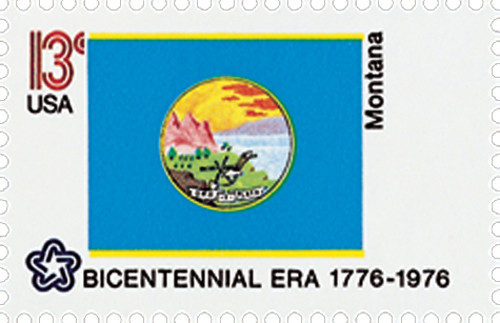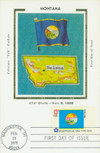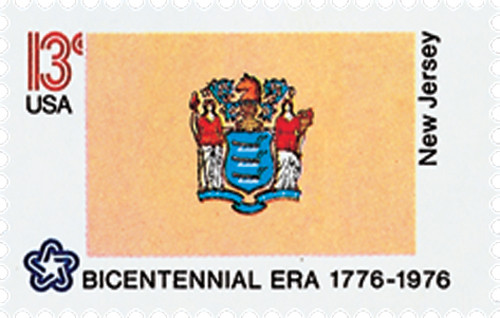
# 1673 - 1976 13c State Flags: Montana
U.S. 1673
1976 Montana
State Flags
American Bicentennial Series
• First time a sheet 50 had all different stamp designs
• Part of the American Bicentennial Series
Stamp Category: Commemorative
Series: American Bicentennial Series
Value: 13¢ First-class postage rate
First Day of Issue: February 23, 1976
First Day City(s): Washington, DC
Quantity Issued: 8,720,100 (panes of 50)
Printed by: Bureau of Engraving and Printing
Printing Method: Photogravure
Format: Sheet of 50
Perforations: 11
Why the stamp was issued:
The United States Postal Service celebrated the American Bicentennial with a full pane of the Union’s fifty state flags.
About the stamp design:
The trains pulled out from Dillon, Montana, in 1898, the first step of a voyage carrying the First Montana Regiment to battle. The United States and Spain were at war, and the First Montana was headed to the Philippines, a journey of 7,000 miles. The regiment's commander, Colonel Harry Kessler, felt the troops needed something special to distinguish them from other units. He privately commissioned a flag for the unit that showed the state seal, with 1st Montana Inf above the seal.
The First Montana finally arrived in Manila 10 days after the city surrendered. During their tour they served in the Philippine Insurrection that directly followed the war. Upon their return to Montana in 1899, Kessler's flag captured the attention of the public. Six years later, the Montana state legislature adopted that flag as the official state flag, with the regiment's name removed.
The seal features a pick, shovel, and plow against a background of forests, fields, and mountains. The Great Falls and Missouri River are also shown. The scene represents Montana's mineral and agricultural wealth, which is reinforced by a banner that says Oro y Plata, or Gold and Silver. In 1981, the state legislature added Montana above the seal.
About the printing process:
Printed by the Bureau of Engraving and Printing on their seven-color Andreotti gravure press (601) which was their work horse for multicolored stamps.
About the American Bicentennial Series:
In the 1970s, America celebrated its 200th anniversary with hundreds of national events commemorating the heroes and historic events that led to our nation’s independence from Great Britain. The U.S. Postal Service issued 113 commemorative stamps over a six-year period in honor of the U.S. bicentennial, beginning with the American Revolution Bicentennial Commission Emblem stamp (U.S. #1432). As a group, the Bicentennial Series chronicles one of our nation’s most important chapters, and remembers the events and patriots who made the U.S. a world model for liberty.
Several of the stamps honored colonial life – craftsmen and communication. Other stamps honored important battles including Lexington and Concord, Bunker Hill, and Saratoga. Significant events such as the Boston Tea Party, the meeting of the First Continental Congress, and the Declaration of Independence were featured as well. The stamps also honored many significant people such as George Washington, Sybil Ludington, Salem Poor, and the Marquis de Lafayette.
Many of the stamps feature classic artwork. For instance, the set of four souvenir sheets picture important events recreated by noted artists such as John Trumbull. The Bicentennial Series also includes an important US postal first – the first 50-stamp se-tenant – featuring all 50 state flags. The format proved to be popular with collectors, and has been repeated many times since.
The American Bicentennial Series is packed with important US history – it tells the story of our nation’s fight for independence through stamps.
History the stamp represents:
On November 8, 1889, Montana was admitted to the Union.
The many Indian tribes living in Montana before the arrival of Europeans could be separated into two groups, those who lived on the Plains and those who lived in the mountains. Plains Indian tribes included the Arapaho, Assiniboine, Atsina, Blackfeet, Cheyenne, and Crow. Mountain-dwelling tribes included the Bannock, Flathead, Kalispel, Kutenai, and Shoshone tribes. The Sioux, Mandan, and Nez Perce hunted in the Montana region, but usually lived elsewhere.
French trappers were probably the first whites to reach Montana, perhaps as early as the 1740s. The Lewis and Clark Expedition explored Montana on their way to the Pacific Coast in 1805 and when returning in 1806. By 1807, fur traders had come to the Montana area. Jesuit missionaries established St. Mary’s Mission in 1841. Located near today’s Stevensville, it was the first attempt to create a permanent settlement in the region. The American Fur Company built Fort Benton on the Missouri River in 1847. This is Montana’s oldest continuously populated town.
The U.S. acquired most of Montana with the Louisiana Purchase of 1803. A treaty gained the northwestern portion of the state with Great Britain in 1846. Montana was administered as part of the territories of Louisiana, Missouri, Nebraska, Dakota, Oregon, Washington, and Idaho.
Gold was discovered in Grasshopper Creek in southwestern Montana in 1862. Further discoveries led to a gold rush. Wild, often lawless, mining towns grew rapidly. To protect their towns, some citizens formed vigilante groups. These problems made people realize Montana needed its own effective government. On May 26, 1864, Montana became a territory.
Richard Grant brought the first cattle herd to Montana from Idaho in the mid-1850s. In 1866, Nelson Story drove a thousand longhorn cattle from Texas to Montana. With the arrival of the Northern Pacific Railroad in 1883, the eastern markets were opened to cattle ranchers. The industry grew quickly. Unfortunately, fierce weather destroyed thousands of Montana cattle during the winter of 1866 and 67. Ranchers continued after this setback, but on a smaller scale.
Two of the most famous Indian battles in the west took place in Montana. Perhaps the most legendary was Custer’s Last Stand. On June 25, 1876, a combined force of Sioux and Cheyenne Indians killed many members of the 7th Cavalry Regiment under Lieutenant Colonel George A. Custer. This battle took place near the Little Big Horn River.
Big Hole was the last major Indian battle in Montana. This conflict started when U.S. troops attempted to force Nez Perce Indians onto a reservation in Oregon. The tribe’s leader, Chief Joseph, led his people on a daring escape toward Canada. After a series of minor battles, U.S. troops fought the Indians for two days at Big Hole in southwestern Montana. Chief Joseph managed to get his people to within 40 miles of the Canadian border before they were captured.
Montana was very attractive to settlers. Between 1880 and 1890, the population grew from about 39,000 to nearly 143,000. The territory's citizenry asked for statehood in 1884. Five years later, on November 8, 1889, Montana achieved statehood.
U.S. 1673
1976 Montana
State Flags
American Bicentennial Series
• First time a sheet 50 had all different stamp designs
• Part of the American Bicentennial Series
Stamp Category: Commemorative
Series: American Bicentennial Series
Value: 13¢ First-class postage rate
First Day of Issue: February 23, 1976
First Day City(s): Washington, DC
Quantity Issued: 8,720,100 (panes of 50)
Printed by: Bureau of Engraving and Printing
Printing Method: Photogravure
Format: Sheet of 50
Perforations: 11
Why the stamp was issued:
The United States Postal Service celebrated the American Bicentennial with a full pane of the Union’s fifty state flags.
About the stamp design:
The trains pulled out from Dillon, Montana, in 1898, the first step of a voyage carrying the First Montana Regiment to battle. The United States and Spain were at war, and the First Montana was headed to the Philippines, a journey of 7,000 miles. The regiment's commander, Colonel Harry Kessler, felt the troops needed something special to distinguish them from other units. He privately commissioned a flag for the unit that showed the state seal, with 1st Montana Inf above the seal.
The First Montana finally arrived in Manila 10 days after the city surrendered. During their tour they served in the Philippine Insurrection that directly followed the war. Upon their return to Montana in 1899, Kessler's flag captured the attention of the public. Six years later, the Montana state legislature adopted that flag as the official state flag, with the regiment's name removed.
The seal features a pick, shovel, and plow against a background of forests, fields, and mountains. The Great Falls and Missouri River are also shown. The scene represents Montana's mineral and agricultural wealth, which is reinforced by a banner that says Oro y Plata, or Gold and Silver. In 1981, the state legislature added Montana above the seal.
About the printing process:
Printed by the Bureau of Engraving and Printing on their seven-color Andreotti gravure press (601) which was their work horse for multicolored stamps.
About the American Bicentennial Series:
In the 1970s, America celebrated its 200th anniversary with hundreds of national events commemorating the heroes and historic events that led to our nation’s independence from Great Britain. The U.S. Postal Service issued 113 commemorative stamps over a six-year period in honor of the U.S. bicentennial, beginning with the American Revolution Bicentennial Commission Emblem stamp (U.S. #1432). As a group, the Bicentennial Series chronicles one of our nation’s most important chapters, and remembers the events and patriots who made the U.S. a world model for liberty.
Several of the stamps honored colonial life – craftsmen and communication. Other stamps honored important battles including Lexington and Concord, Bunker Hill, and Saratoga. Significant events such as the Boston Tea Party, the meeting of the First Continental Congress, and the Declaration of Independence were featured as well. The stamps also honored many significant people such as George Washington, Sybil Ludington, Salem Poor, and the Marquis de Lafayette.
Many of the stamps feature classic artwork. For instance, the set of four souvenir sheets picture important events recreated by noted artists such as John Trumbull. The Bicentennial Series also includes an important US postal first – the first 50-stamp se-tenant – featuring all 50 state flags. The format proved to be popular with collectors, and has been repeated many times since.
The American Bicentennial Series is packed with important US history – it tells the story of our nation’s fight for independence through stamps.
History the stamp represents:
On November 8, 1889, Montana was admitted to the Union.
The many Indian tribes living in Montana before the arrival of Europeans could be separated into two groups, those who lived on the Plains and those who lived in the mountains. Plains Indian tribes included the Arapaho, Assiniboine, Atsina, Blackfeet, Cheyenne, and Crow. Mountain-dwelling tribes included the Bannock, Flathead, Kalispel, Kutenai, and Shoshone tribes. The Sioux, Mandan, and Nez Perce hunted in the Montana region, but usually lived elsewhere.
French trappers were probably the first whites to reach Montana, perhaps as early as the 1740s. The Lewis and Clark Expedition explored Montana on their way to the Pacific Coast in 1805 and when returning in 1806. By 1807, fur traders had come to the Montana area. Jesuit missionaries established St. Mary’s Mission in 1841. Located near today’s Stevensville, it was the first attempt to create a permanent settlement in the region. The American Fur Company built Fort Benton on the Missouri River in 1847. This is Montana’s oldest continuously populated town.
The U.S. acquired most of Montana with the Louisiana Purchase of 1803. A treaty gained the northwestern portion of the state with Great Britain in 1846. Montana was administered as part of the territories of Louisiana, Missouri, Nebraska, Dakota, Oregon, Washington, and Idaho.
Gold was discovered in Grasshopper Creek in southwestern Montana in 1862. Further discoveries led to a gold rush. Wild, often lawless, mining towns grew rapidly. To protect their towns, some citizens formed vigilante groups. These problems made people realize Montana needed its own effective government. On May 26, 1864, Montana became a territory.
Richard Grant brought the first cattle herd to Montana from Idaho in the mid-1850s. In 1866, Nelson Story drove a thousand longhorn cattle from Texas to Montana. With the arrival of the Northern Pacific Railroad in 1883, the eastern markets were opened to cattle ranchers. The industry grew quickly. Unfortunately, fierce weather destroyed thousands of Montana cattle during the winter of 1866 and 67. Ranchers continued after this setback, but on a smaller scale.
Two of the most famous Indian battles in the west took place in Montana. Perhaps the most legendary was Custer’s Last Stand. On June 25, 1876, a combined force of Sioux and Cheyenne Indians killed many members of the 7th Cavalry Regiment under Lieutenant Colonel George A. Custer. This battle took place near the Little Big Horn River.
Big Hole was the last major Indian battle in Montana. This conflict started when U.S. troops attempted to force Nez Perce Indians onto a reservation in Oregon. The tribe’s leader, Chief Joseph, led his people on a daring escape toward Canada. After a series of minor battles, U.S. troops fought the Indians for two days at Big Hole in southwestern Montana. Chief Joseph managed to get his people to within 40 miles of the Canadian border before they were captured.
Montana was very attractive to settlers. Between 1880 and 1890, the population grew from about 39,000 to nearly 143,000. The territory's citizenry asked for statehood in 1884. Five years later, on November 8, 1889, Montana achieved statehood.


















